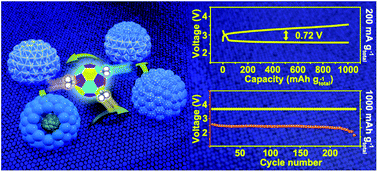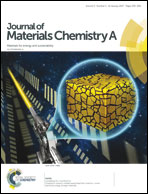Yolk–shell Co2CrO4 nanospheres as highly active catalysts for Li–O2 batteries: understanding the electrocatalytic mechanism†
Abstract
Controlling the geometric morphology and distributive location of discharge products play an important role in the reversibility and efficiency of Li–O2 batteries. This work presents novel Co2CrO4 nanospheres (CCO) prepared via a facile method, which are applied as the electrocatalysts for Li–O2 batteries. The as-prepared CCO was characterized by XRD, XPS, SEM, TEM, BET, and TG measurements. The CCO exhibited a yolk–shell microstructure, which could facilitate fast Li+ and O2 diffusion as well as possessing enough space for the discharge product deposition. In comparison to the performance of the cell without catalyst, the overpotential of the cell with CCO was apparently reduced and the cyclability significantly enhanced. Based on the experimental results and DFT calculations, direct evidence of the CCO employment being linked to the Li2O2 morphology was provided. In addition, a catalytic mechanism was proposed. Furthermore, fundamental information about the key factors and steps involved in the Li2O2 formation and decomposition was revealed. We expect that this study gives insight into the development of electrocatalysts, the selection of O2 electrode materials, and the design of O2 electrodes for Li–O2 batteries, as well as advancing our understanding of the catalytic mechanism.


 Please wait while we load your content...
Please wait while we load your content...